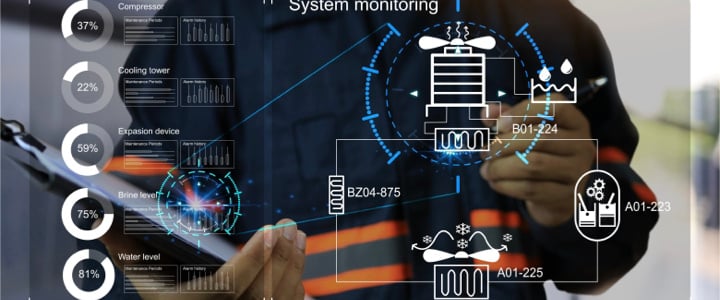Author: Editorial board

Smart HVAC: the impact of digitalisation on installations
Digitalisation is revolutionising every sector and the system engineering sector is no exception. In particular, the HVAC (Heating, Ventilation and Air Conditioning) sector has been undergoing a profound transformation for some time now thanks to the introduction of advanced technologies. So-called “Smart HVAC” systems, being presented as an effective response to both the limitations of traditional systems and new market demands, are in fact gaining wide popularity among professionals and end users.
In this article, we will take a closer look at how smart devices and IoT connectivity are transforming HVAC systems, and then conclude with an overview of how SLIM fits into this scenario to support companies in introducing innovation and smart solutions.
If you are a professional in the Heating, Ventilation and Air Conditioning industry, click on the button below and download the free infographic to find out what the trends are for the development of heating and air conditioning systems of the future.
The Smart HVAC concept and its benefits
Equipped with sensors, actuators and advanced technologies, Smart HVAC systems represent the latest evolution in air handling and treatment systems. These products are distinguished by 5 main features, each of which offers significant benefits: connectivity, automation and artificial intelligence, predictive maintenance, voice control and integration with other home automation systems.
- Connectivity: because Smart devices are connected to each other and to the Internet, users can monitor and adjust settings - such as temperature, humidity, air quality and energy consumption - in real time and from anywhere. Centralised resource management and reduced CO2 emissions thus make the Smart HVAC environment ideal for saving time and combating global pollution.
- Automation and Artificial Intelligence: thanks to advanced AI software, Smart HVAC systems are able to learn users’ habits and automatically adapt settings, even according to ambient conditions. For example, a system can reduce the heating when it detects that the house is empty and turn it back on just before the occupants return, thus ensuring high levels of comfort and energy savings.
- Predictive maintenance: one of the main advantages of this modern system is the ability to predict failures and maintenance needs. By analysing the data collected by the sensors, potential problems can be identified before they occur and, consequently, downtime and repair costs can be reduced.
- Voice control: many Smart systems are compatible with voice assistants such as Google Assistant and Amazon Alexa. By simply using voice command, control of the system is as effective as it is immediate and intuitive.
- Integration with other systems: In order to make an environment, be it at home or at work, adaptable to any kind of demand from anyone, the design of these products is intended to provide the opportunity for integration with other home automation systems, such as lighting, security and control of household appliances.
Smart HVAC systems: emerging technologies and practical applications
Emerging technologies are increasingly pushing innovation in the HVAC sector forward, opening up new opportunities for improvement.
One of the most significant is the Internet of Things, which enables the creation of intelligent networks, consisting of multiple devices, including HVAC, that collaborate with each other on a daily basis by exchanging important information. Based on these data, artificial intelligence then optimises the performance of the systems in real time. For example, machine learning algorithms can predict heating or cooling demand based on variables such as weather forecasts and building occupancy. Lastly, big data analysis makes it possible to identify patterns and trends in energy consumption, providing valuable guidelines to maximise overall efficiency and improve system maintenance.
In residential settings, such applications offer personalised control of the various areas of the home, with smart thermostats that adapt to the occupants’ schedules and automated ventilation equipment for air quality.
In commercial buildings, centralised management and AI technologies enable large-scale monitoring of the entire facility, improving energy efficiency and reducing operating costs. In addition, the systems can be integrated with renewable energy systems to maximise self-consumption and reduce dependence on the electricity grid. In industrial settings, the advanced sensors and predictive maintenance ensure stability and safety in every space, monitoring temperature and humidity and ensuring uninterrupted operations. Lastly, public infrastructures, such as hospitals and schools, benefit from improved air quality management and thermal comfort. Intelligent systems adapt to the specific needs of each environment, improving the health and well-being of users.
SLIM’s solutions for smart HVAC systems
In an ever-changing industry like Heating, Ventilation, and Air Conditioning (HVAC), light signalling is more than just an indication of operation. It is crucial for ensuring the operational efficiency, security and control of systems. In addition, it can play an important aesthetic role, giving the device a visually attractive appearance.
This is why, for more than 50 years we at SLIM have been offering companies in the industry safe, quality light products that can be integrated into boilers, water heaters, air conditioners and more.
In addition to the production of signalling and standard components, which is essential for the functional aspect, we at SLIM are also open to the possibility of starting collaborations for the development of customised lighting solutions, so that light signalling for domestic heating and air conditioning equipment can be better adapted to the desired space and aesthetics. The components that are most suitable for the development of customised aesthetic lighting include strip LED and optical fibre, which are especially useful when one wants to illuminate particular details of HVAC devices, such as the logo, in a minimal and original way.
Are you interested in receiving more details about our products or our cooperation? Click below and do not hesitate to contact us for more information.


